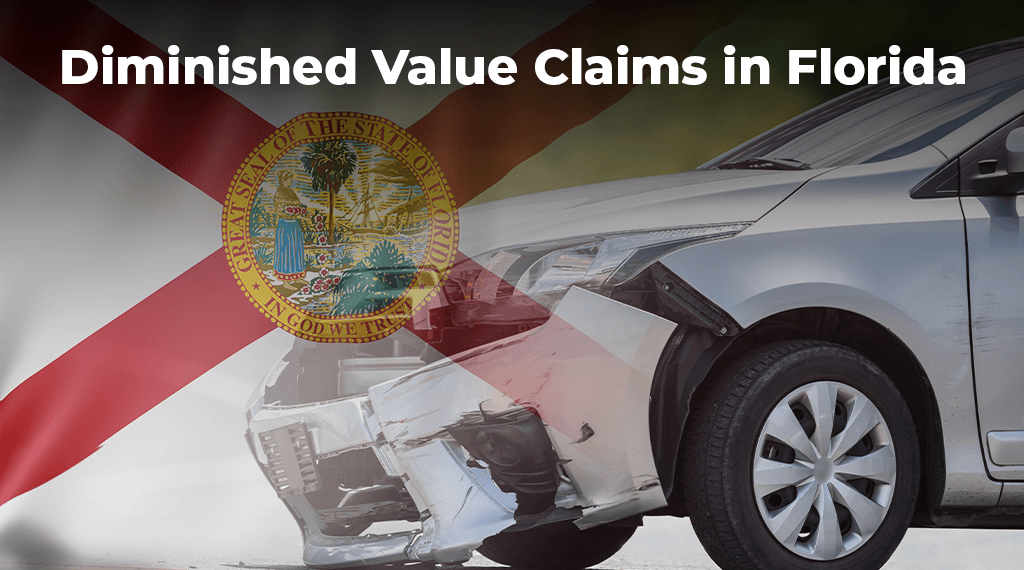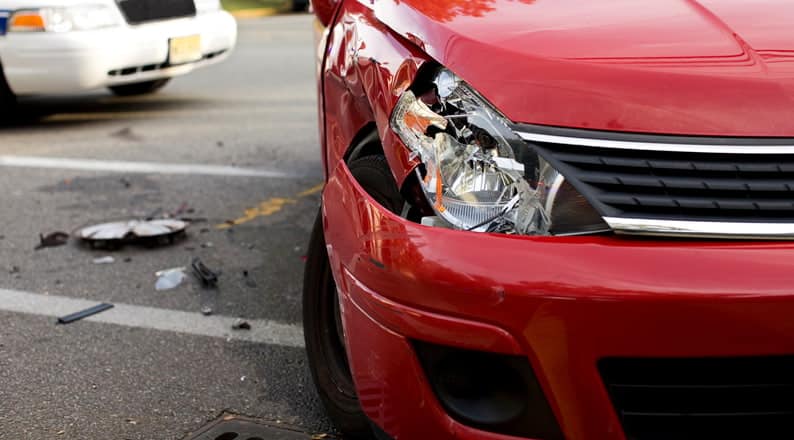Florida car owners lose $500 to $5,000 in their vehicle’s market value after an accident, even with perfect repairs. This drop in value, called diminished value, can hurt your car’s worth.
Florida law protects drivers after an accident. You can claim the difference between your car’s value before and after repairs from your insurance company. But you need to prove your case with proper appraisals and strong evidence. Fault determination and time limits also play a key role. Luxury and newer cars often see bigger drops in value. Florida gives you four years to file these property damage claims.
This piece covers what Florida drivers must know to win their diminished value claims. You’ll learn about the 17c formula that insurance companies use. We’ll also show you how to gather the right documents and handle insurance negotiations effectively.

Table of Contents
- 1 What is a Diminished Value Claim in Florida?
- 2 Types of Diminished Value You Can Claim
- 3 Are You Eligible to File a Diminished Value Claim in Florida?
- 4 How to File a Diminished Value Claim in Florida
- 5 How to Calculate Diminished Value and Maximize Your Payout
- 6 Summing all up
- 7 Here are some FAQs about diminished value claim Florida:
- 7.1 Who pays for property damage in a car accident in Florida?
- 7.2 What is the diminished value law in Florida?
- 7.3 What is the 51 percent rule in Florida?
- 7.4 Do I have to pay my deductible if the accident wasn’t my fault in Florida?
- 7.5 How long after an accident can you still make a claim?
- 7.6 What is the 90 day rule for insurance claims in Florida?
- 7.7 What is the 25ft rule in Florida?
- 7.8 What is the 80 20 rule in Florida?
- 7.9 Is Florida no longer a no-fault state?
What is a Diminished Value Claim in Florida?
A diminished value claim in Florida lets vehicle owners ask for money back when their car loses market value after an accident. This happens whatever the repair quality. Your car automatically loses worth after damage and repairs – something Florida drivers usually find out only when they try to sell or trade in their vehicles.
Definition and ground impact
Diminished value is the difference between what your car was worth before an accident and after repairs. Your car’s value drops even if repairs make it look and work like new. This happens because buyers and dealerships don’t want cars with accident history, even with perfect repairs.
This hits your wallet hard – buyers offer less for cars with accident history. It limits your chances to:
- Get full value on trade-ins
- Sell privately at normal prices
- Get predicted values for refinancing or leasing
Luxury and newer vehicles take the biggest hit. High-end cars lose value fast after accidents. So, Florida’s diminished value claim system lets you get compensation from the at-fault driver’s insurance.
Why it matters even after full repairs
Insurance companies might tell you repairs fix everything. They don’t. Here’s why:
Your car’s accident history shows up on Carfax or AutoCheck reports. This immediately tells potential buyers about previous damage. That history sticks with your car forever.
Repaired vehicles might have safety issues that show up later. These worries, real or not, hurt market value whatever the repair quality.
Money problems don’t go away after the accident. When it’s time to sell or trade in, you’ll get substantially less than if your car never had an accident. This feels especially unfair if the accident wasn’t your fault.
Common misconceptions about diminished value
Florida drivers often miss out on fair compensation because they believe these myths:
The first myth says repairs bring back full value. People think perfect-looking repairs mean normal value. That’s not true – accident history always cuts market value.
There’s another reason people don’t file claims – they think only big accidents count. The truth is even small accidents can lead to valid claims in Florida, especially with newer cars.
On top of that, many think insurance covers diminished value automatically. Regular policies don’t handle this loss unless you take specific steps.
Some think the value drop doesn’t matter much. Actually, you could lose hundreds or thousands depending on your car’s age, make, model, and condition before the accident.
Filing a diminished value claim in Florida helps you get back money lost from lower resale value. You shouldn’t pay for someone else’s driving mistake.
Types of Diminished Value You Can Claim
Florida drivers need to understand three different types of diminished value claims to get the maximum compensation after an accident. Your potential recovery amount depends on the specific scenario and repair timeline.
Inherent diminished value
The most common type of diminished value claims in Florida involves inherent diminished value. Your vehicle’s market value automatically drops because it has an accident history, even with perfect repairs.
The market shows a clear pattern – vehicles with accident records sell for less money. Buyers offer lower prices during trade-ins or private sales. Your vehicle’s history stays on Carfax reports, and future buyers will always know about the accident.
Florida drivers usually base their insurance claims on inherent diminished value. The value drops whatever the repair quality, and this applies to almost all accidents where the vehicle wasn’t at fault.
Immediate diminished value
Immediate diminished value looks at how much your vehicle’s worth drops right after the crash but before any repairs. This measures the original fall in market value at the moment of damage.
Florida drivers rarely file immediate diminished value claims, though they’re perfectly legal. Insurance companies typically pay for repairs instead of pre-repair sales. You might use this type of claim if you sold or traded your vehicle right after the accident without fixing it.
These claims work best in specific cases. You might need one if you sold the damaged vehicle or faced long repair delays.
The third type deals with poor repairs that cause extra value loss beyond the inherent drop. This happens when:
- Repairs don’t fully fix the vehicle
- Mechanics use cheaper or non-original parts
- You can see defects or misaligned parts after repairs
- The vehicle’s structure remains weak
- New mechanical problems show up from the accident damage
This type matters most when inexperienced shops handle repairs or insurance companies limit repair options. You’ll need to prove that poor quality repairs made your vehicle worth even less.
All three types could fit your case. Most successful Florida claims focus on inherent diminished value because it affects every repaired vehicle. Florida law recognizes that accident records permanently lower your vehicle’s market value. You can get compensation through a well-documented diminished value claim.

Are You Eligible to File a Diminished Value Claim in Florida?
You need to understand several legal factors to file a diminished value claim in Florida. These factors can determine if your case succeeds or fails. Not every vehicle owner can get compensation because Florida law has specific requirements.
Third-party vs. first-party claims
The difference between third-party and first-party claims is significant when you seek compensation for diminished value in Florida. A third-party claim happens when you file against the at-fault driver’s insurance company. A first-party claim means you file with your own insurance provider.
Florida law favors third-party diminished value claims. Yes, it is your legal right to seek compensation through their insurance when another driver causes your accident.
First-party diminished value claims have major restrictions in Florida. You usually can’t file these claims against your own insurance company unless your policy specifically allows it. You might get coverage through Uninsured Motorist Property Damage (UMPD) provisions, but this is rare.
Fault requirements under Florida law
Your eligibility for a diminished value claim in Florida depends on these fault-related conditions:
- The other driver must be the main party responsible for the accident
- You can’t be the one who caused the collision
- Your vehicle’s market value must show a clear drop
- Repairs can’t fully restore your vehicle to its pre-accident state
Florida uses a modified comparative negligence system. The other driver needs to be at least 51% at fault before you can collect damages. Your compensation will decrease based on your fault percentage if you share responsibility.
Time limits and statute of limitations
Florida law gives you four years from your accident date to file diminished value claims. This deadline applies to property damage claims that include diminished value.
Missing this deadline means you’ll probably lose your right to get compensation for your vehicle’s diminished value. Starting the claims process right after your accident makes good sense.
Quick action helps beyond meeting legal deadlines. Filing early lets you gather better evidence. This includes detailed photographs, police reports, witness statements, and video surveillance that might disappear over time.
How to File a Diminished Value Claim in Florida
Filing a diminished value claim in Florida needs a systematic process to boost your success chances. Insurance companies often fight these claims. You’ll need proper documentation and a smart approach. Here’s how to guide you through this process.
Step 1: Complete all repairs
Make sure your vehicle repairs are done before you file your diminished value claim. This first step helps your claim show the vehicle’s actual condition after repairs. Your case could suffer if you file too early, since the final assessment must show your vehicle’s state after professional restoration. Keep all repair receipts and documentation from your authorized repair facility. These documents are the foundations of your claim.
Step 2: Gather documentation and photos
Your next step is to put together detailed documentation that supports your claim. Your evidence package should include:
- The accident report or police report
- Repair invoices detailing all work performed
- Photos of your vehicle before, during, and after repairs
- Vehicle history reports (like Carfax or AutoCheck)
- Proof of vehicle ownership at the time of the accident
Good documentation makes your position stronger when you deal with insurance companies that usually try to minimize payouts.
Step 3: Get a professional appraisal
A professional diminished value appraisal is maybe the most vital step. These specialized appraisals give an unbiased look at your vehicle’s lost value. They’re a great way to get leverage when dealing with insurers. A qualified appraiser looks at:
- Your vehicle’s pre-accident value
- Post-repair value assessment
- Detailed analysis of repair documentation
- Inspection of your vehicle’s current condition
- Determination of the specific diminished value amount
Insurance companies and courts take these professional appraisals seriously because they follow recognized standards.
Step 4: Send a demand letter
Your next move is to write a formal demand letter to the at-fault driver’s insurance company. This letter should:
- Reference the accident date and circumstances
- State clearly that the other driver’s negligence caused your damages
- Include your diminished value appraisal findings
- Specify your requested compensation amount
- Set a reasonable timeframe for response (typically 15 days)
Keep your tone professional but firm. Show that you know your rights and have done your research.
Step 5: Negotiate or escalate
Insurance companies usually reject claims at first or offer low settlements. You have several options if talks hit a wall:
- File a complaint with Florida’s Department of Financial Services
- Take the claim to small claims court
- Talk to an attorney who specializes in diminished value claims
Stay persistent but professional during negotiations. Provide any extra documentation the insurer asks for quickly.
How to Calculate Diminished Value and Maximize Your Payout
Your vehicle’s diminished value calculations are the life-blood of successful claims in Florida. Insurance companies use standard methods that might undervalue your loss. You really need to understand these calculations.
Using the 17c formula
The 17c formula, which came from the Mabry v. State Farm lawsuit in Georgia, stands as the insurance industry’s standard calculation method. Here’s how it works in three steps:
- Calculate 10% of your vehicle’s pre-accident market value (NADA or KBB value)
- Apply a damage multiplier (0.00-1.00) based on severity (1.00=severe structural damage, 0.00=no structural damage)
- Apply a mileage multiplier (1.00 for 0-19,999 miles, decreasing to 0.00 for 100,000+ miles)
This formula often creates artificially low valuations that help insurers more than claimants.
Market-based comparison methods
Market-based approaches are a great way to get better results by comparing similar vehicles with and without accident histories. This method shows more accurate results by looking at:
- Current local listings of comparable vehicles
- Regional market conditions affecting your specific vehicle type
- Actual selling prices instead of theoretical formulas
These comparisons give real-life evidence of your vehicle’s diminished value that courts find more convincing than formula calculations.
Using a diminished value calculator
Online diminished value calculators give quick estimates but have major limitations. These tools usually:
- Use rigid parameters that rarely fit local market conditions
- Miss unique vehicle features or repair quality
- Give rough guesses rather than accurate assessments
These calculator results should be starting points for negotiations, not final values.
When to hire a professional appraiser
Professional diminished value appraisals cost between $350-$699 but give you many benefits:
- Detailed documentation of your vehicle’s condition
- Expert analysis of repair quality and remaining issues
- Market-specific values that match local conditions
- Strong third-party evidence that helps negotiations
- Court-ready formal reports if you need to litigate
Factors that affect your claim amount
Your diminished value calculation depends on several things:
- Vehicle age and mileage (newer vehicles lose more value)
- Pre-accident condition and maintenance history
- Damage severity and structural impact
- Repair quality and parts used (OEM versus aftermarket)
- Current market demand for your make and model
Luxury vehicles with significant damage might lose $15,000-$20,000 in value.
Summing all up
Florida vehicle owners need to know about diminished value claims after accidents. Your car loses a lot of market value after a collision, whatever the repair quality. Average vehicles can lose $500 to $5,000, while luxury or newer models face even bigger drops in value.
You’ll need solid preparation to get compensation. Check if you can file a third-party claim against the at-fault driver’s insurance. Next, collect all your paperwork – repair receipts, photos, and accident reports. A professional appraisal will give you better results than just trusting insurance company calculations.
Insurance companies use the 17c formula, but it usually undervalues your loss. Market-based comparison methods show the ground reality better. Professional appraisals cost between $350-$699 upfront but give more accurate values and help you negotiate better.
Vehicle owners have four years under Florida law to file their claims. Quick action after repairs will boost your chances of success. Most insurance companies fight these claims or start with tiny settlement offers. Your success depends on keeping detailed records and staying persistent.
Money lost through diminished value goes way beyond just fixing your car. This loss hits your trade-in value, private sale price, and future financing options. Fighting for fair compensation protects your investment and keeps you from paying for someone else’s mistake.
Here are some FAQs about diminished value claim Florida:
Who pays for property damage in a car accident in Florida?
In Florida, the at-fault driver’s property damage liability insurance is typically responsible for paying for the other party’s vehicle repairs. If the at-fault driver is uninsured, you may need to use your own collision coverage or pursue a claim directly against the driver to recover your losses.
What is the diminished value law in Florida?
Florida law recognizes diminished value claims, which seek compensation for the loss in a vehicle’s market value after it has been repaired following an accident. You can file this type of claim against the at-fault driver’s insurance company to recover the difference between your car’s pre-accident value and its value after repairs.
What is the 51 percent rule in Florida?
The 51 percent rule in Florida refers to the state’s comparative negligence law. This rule states that you can recover damages from another party only if you are found to be less than 51 percent at fault for the accident. If you are 51 percent or more at fault, you are barred from recovering any compensation.
Do I have to pay my deductible if the accident wasn’t my fault in Florida?
You may still have to pay your deductible upfront if you use your own collision coverage to repair your vehicle, even if the accident was not your fault. However, your insurance company may then attempt to recover the amount of your deductible from the at-fault driver’s insurance company through a process called subrogation.
How long after an accident can you still make a claim?
The statute of limitations for filing a property damage or personal injury lawsuit after a car accident in Florida is generally four years from the date of the accident. It is important to be aware of this deadline, as failing to file a claim within this time frame will typically result in your case being dismissed by the court.
What is the 90 day rule for insurance claims in Florida?
The 90 day rule in Florida refers to the time frame an insurance company has to pay or deny a claim after receiving satisfactory proof of loss. If the insurer fails to pay a valid claim within this 90-day period, they may be subject to penalties and interest under Florida’s insurance regulations.
What is the 25ft rule in Florida?
The 25-foot rule in Florida is a traffic law that requires drivers to maintain a safe distance when following emergency vehicles. Specifically, drivers must not follow within 25 feet of any fire engine or other emergency vehicle that is answering an alarm, to ensure the safety of emergency personnel and avoid interfering with their operations.
What is the 80 20 rule in Florida?
The 80/20 rule in Florida is a principle related to total loss vehicle claims. It states that if the cost to repair a damaged vehicle exceeds 80 percent of its actual cash value, the insurance company will typically declare it a total loss. This rule helps determine whether a vehicle should be repaired or considered a constructive total loss.
Is Florida no longer a no-fault state?
As of the current date, Florida remains a no-fault state for auto insurance. This means that after a car accident, your own Personal Injury Protection (PIP) insurance is primarily responsible for covering your medical expenses and lost wages, regardless of who was at fault for the collision.


